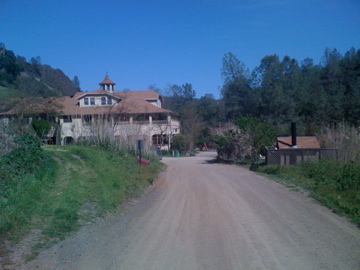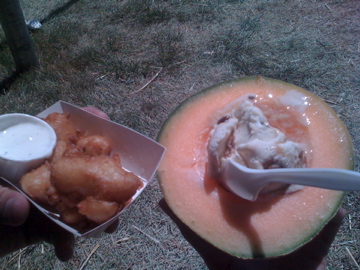 I sat in the sun, butt naked and heat dazed, my starving skin soaking up all the UV it’d been hungry for since my trip to LA. The sulfur smell of the hot springs had stopped burning my nose, and I was in that drool state of relaxation where everything floats in and out of your consciousness like a dream. The bits of conversation from down the deck came to me in whiffs, like BBQ or the burning of some far-off fire.
I sat in the sun, butt naked and heat dazed, my starving skin soaking up all the UV it’d been hungry for since my trip to LA. The sulfur smell of the hot springs had stopped burning my nose, and I was in that drool state of relaxation where everything floats in and out of your consciousness like a dream. The bits of conversation from down the deck came to me in whiffs, like BBQ or the burning of some far-off fire.
“You know, Mark called me on Friday. And he started up again. And I said, you know, like we’d practiced, ‘I am not going to participate in this conversation with you.'”
The words roused me a little. Not so much really the words, but the careful way in which they were recited—deliberate, practiced, the memorization of an actor who knows the scene but hasn’t quite figured out their character’s motivation.
The patter of bare feet and a sleek ripple of water. “Oh, Myra, I didn’t tell you,” the voiced repeated. “I got to use that tool we talked about, when I told Mark: ‘I am not going to participate in this conversation with you.’ It felt so good!”
Wilbur Hot Springs is a retreat place, and that’s what I’d come for. That’s what we’d all come for, driven the two-line highway through pastoral postcards, past cheese-commercial cows, down a bumping dirt road where the dust plumed and twisted behind us like everything we’d meant to leave behind.
 Wilbur is the kind of place that makes you lapse into cheesy cliches (partly because your brain is too full of steam to think straight). A Victorian mansion “nestled” into the “rolling” California hills, it’s an uber-NorCal experience, an “oasis.” Everything is solar-powered. The natural hot springs are directed into four flumes clustered around a clothing-optional deck. There’s a communal kitchen where guests cook their own meals, and instruments for evening jam sessions. Everyone talks in low, soothing voices, and the place smells like well-oiled wood. Sustainability and spiritualism; regrouping, reconnecting, getting off the grid and soaking in 114 degree water—you know, the kind of hippie shit a punk rock kid like me used to scoff at. Until I went up on a gift certificate a couple years ago with a similarly suspicious friend.
Wilbur is the kind of place that makes you lapse into cheesy cliches (partly because your brain is too full of steam to think straight). A Victorian mansion “nestled” into the “rolling” California hills, it’s an uber-NorCal experience, an “oasis.” Everything is solar-powered. The natural hot springs are directed into four flumes clustered around a clothing-optional deck. There’s a communal kitchen where guests cook their own meals, and instruments for evening jam sessions. Everyone talks in low, soothing voices, and the place smells like well-oiled wood. Sustainability and spiritualism; regrouping, reconnecting, getting off the grid and soaking in 114 degree water—you know, the kind of hippie shit a punk rock kid like me used to scoff at. Until I went up on a gift certificate a couple years ago with a similarly suspicious friend.
We’ve been jonesing to get back ever since.
Retreat is what these chatting women on the deck had also come for, and like retreat, they were something, a certain kind of woman, a younger incarnation of me would have scoffed at: middle-aged, middle-class, white, all-American. Bad hair and worry lines. I’ve grown less judgmental in my old age, and in my hot-spring-infused sedation, observed them detachedly, from an almost anthropological distance.
They’d come on day passes. They weren’t entirely comfortable, held their robes and towels around them self-consciously, seemed self-conscious about being self-conscious—they averted eyes, glanced this way and that before letting go and slipping naked into the steaming water.
I’d pieced together their conversations, about ex-husbands and astrology, how to figure your aura energy by the kinds of animals you attracted (“You got lizards and butterflies; I got bit by a tick!”). This day trip to Wilbur appeared to be the culmination of a healing workshop. The leader of the group was some kind of psychic—not a predictive one, she assured, but one that dealt more in energies, a kind of cosmic therapist. They weren’t super New-Agey about it, talked in a kind of down-to-earth tone that made them seem less like people on board some kind of bullshit train, and more like people genuinely seeking, genuinely lost and hurt and looking for something, some kind of solidity.
 “I am not going to participate in this conversation with you.” The statement rang in my ears, plucking me out of my sun-drenched stupor. The speaker’s voice held in it all the excitement of a pupil who’d just felt a switch flip—who’d practiced the arithmetic but wasn’t sure the equation would work for them, with their own dull and trembling pencil. But it wasn’t a young voice and a glance at the body from which it issued revealed a gravity, breasts heavy and hips wide, a child-bearing body.
“I am not going to participate in this conversation with you.” The statement rang in my ears, plucking me out of my sun-drenched stupor. The speaker’s voice held in it all the excitement of a pupil who’d just felt a switch flip—who’d practiced the arithmetic but wasn’t sure the equation would work for them, with their own dull and trembling pencil. But it wasn’t a young voice and a glance at the body from which it issued revealed a gravity, breasts heavy and hips wide, a child-bearing body.
My God, I thought, to have lived that long and only now have learned to say that.
The woman’s comment, the thrill with which she yielded it, struck me as tragic, in a particularly female kind of way—that a woman could go that long in her life without having learned to say no before.
Boundaries. Standing up for yourself. Not taking shit. They’re vital things for us girls to learn. You flat out won’t make it in this world without them, I’ve come to believe, and I don’t just mean with manipulative ex-husbands. You’ve got to learn where the world stops and you begin, what is and is not okay with you, and how to be firm and true to that. Cause you’re not going to make it—ride the buses or walk the streets or, shit, travel the world—you’re not going to survive the barrage of shit hurled at you without learning the word “no.”
And there, on that sun deck, a wave of gratitude swept over me, like the spring breeze on my pink and steaming body, for my mother. My tough-as-nails, take-no-shit mother.
My mother, my model: pretty and blond and trained in karate. She worked in factories, held her own in the male-dominated world of politics, worked in West Oakland during the worst of the crack years, dared a scab to follow through with their threat to punch her on the picket line (they punked out). It stems from that: my childhood love of Tina Turner and my vow that if, when I was older, I ever went on a date with a guy who tried to make me do something I didn’t want to, I’d “kick him in the nuts with my high heels”; my busted-Converse affection for Riot Grrls, Le Tigre, Anne Sexton and Sylvia Plath. And it stretches before that: my grandmothers, no-nonsense Midwest girls who endured Depression poverty and marched in Civil Rights protests.
I come from a long line of tough ladies. I can’t ever forget I stand upon the ground they forged for me. It’s a generational adventure, this learning of how to be a woman in the world, and what my mother and grandmothers fought for is in me, my blood. So much so that it still surprises me, blinking-eyed shocks me, when other women ask me how I have the “bravery” to travel alone. It simply never occurred to me to not have the bravery.
In that sun-drenched moment, any residual judgment melted away, just like the knots in my lower back unclenched in the hot, healing water. It may have seemed tragically late to learn how to make boundaries, she may have had to take a healing workshop with a psychic, but this woman had learned. And she sat now, naked and free, gently turning pink in the sunlight of it.




































Recent Comments